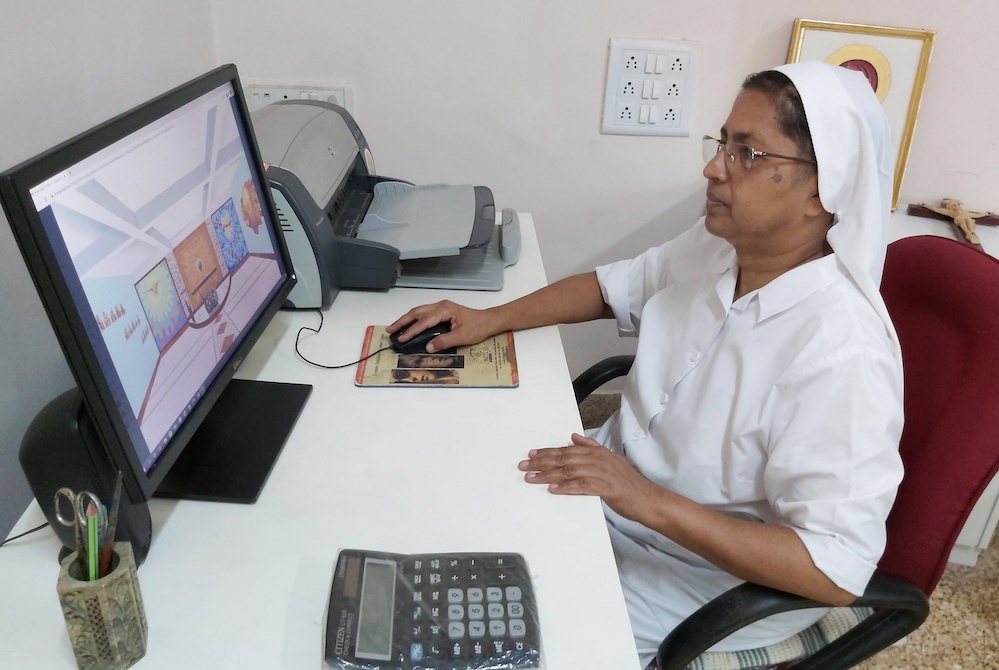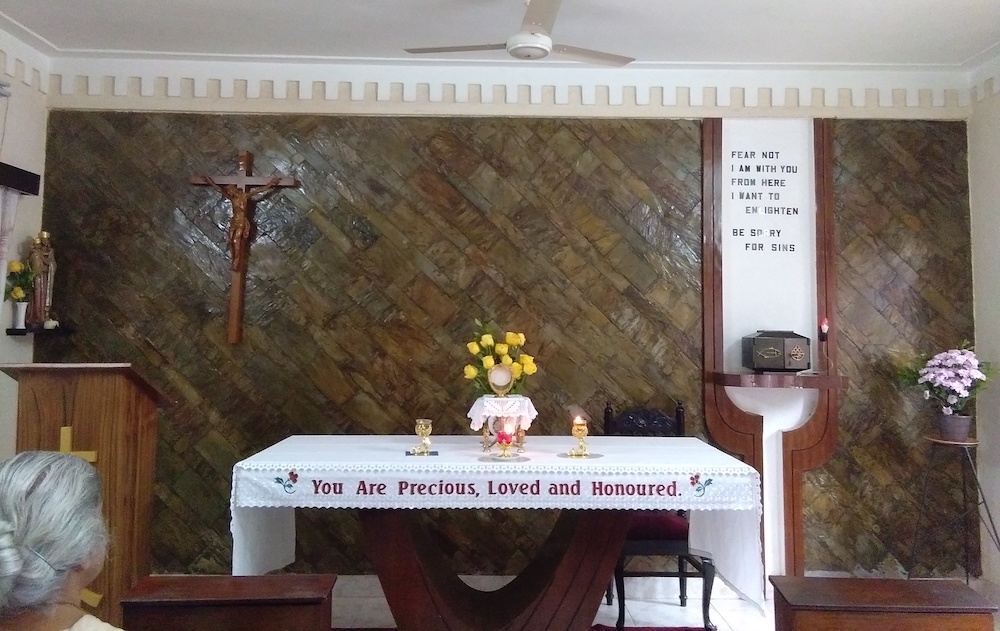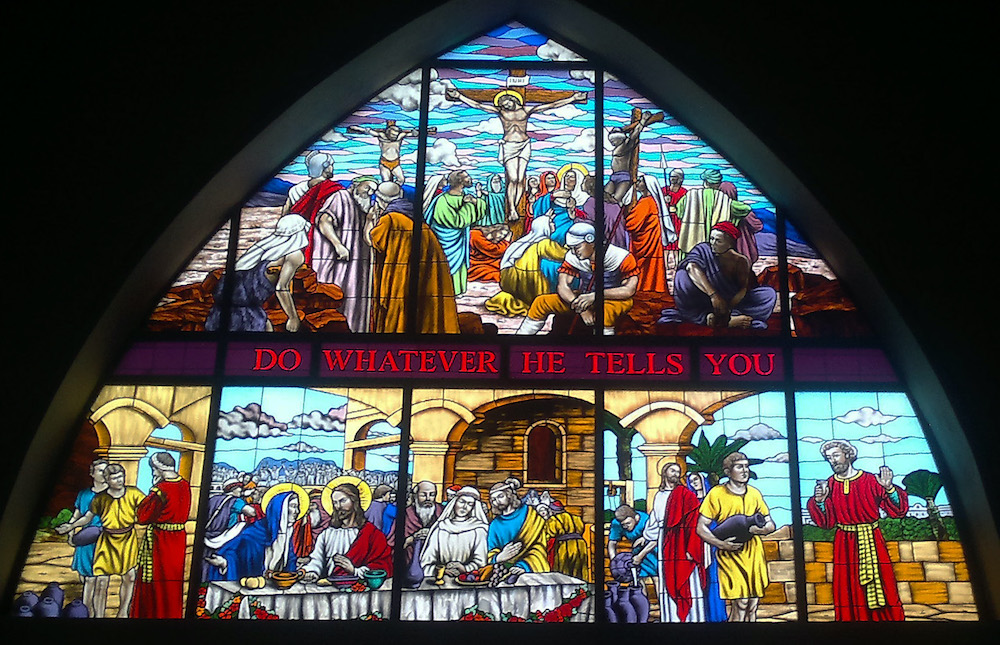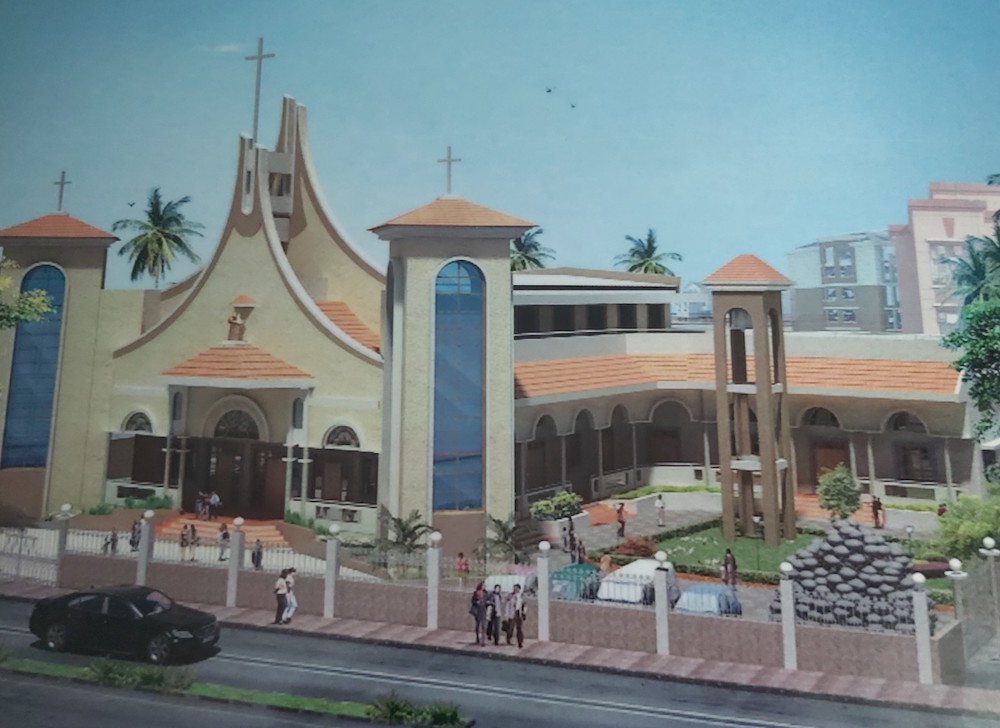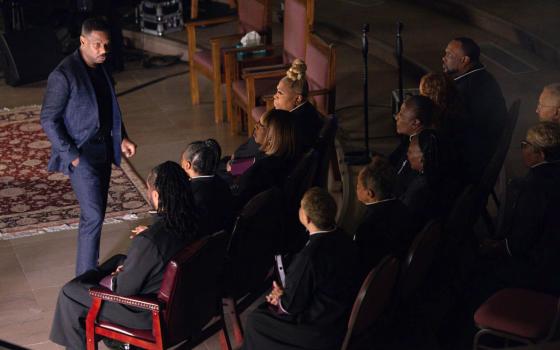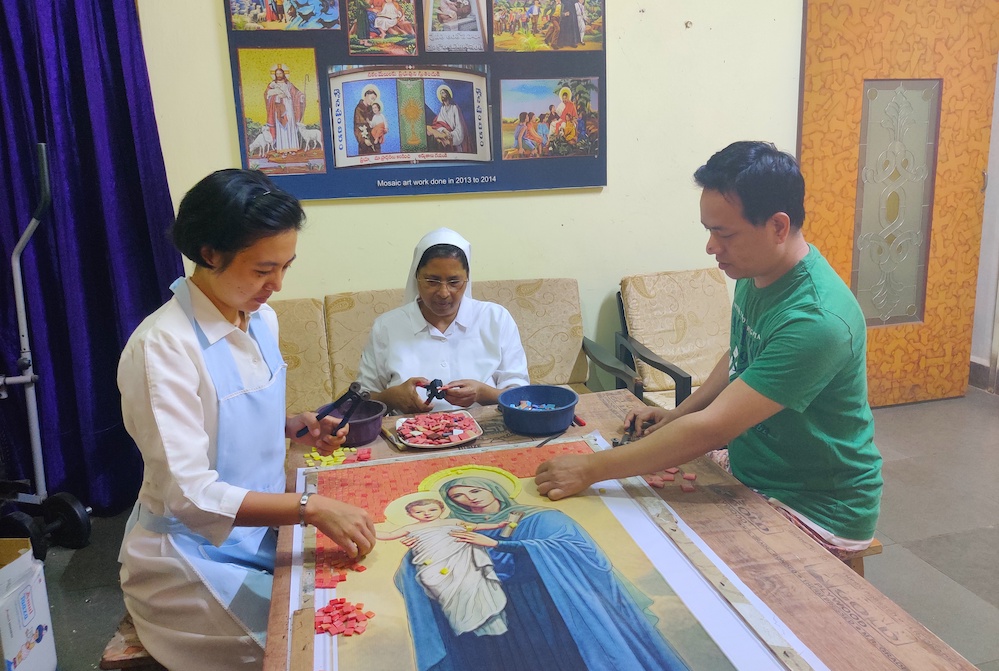
Sr. Vimala Joseph Thottumannil of the Pious Disciples of the Divine Master, center, works on a mosaic in her studio in Bandra, a suburb of Mumbai, western India, with Sr. Bibiana Thaipaoliko, left, and Dinesh Singh, a staff member. (Provided photo)
Sr. Vimala Joseph Thottumannil has lived in the same convent in Mumbai, western India, for more than 30 years because of her specialized work: architecture.
The member of the Italy-based Pie Discepole del Divin Maestro (Pious Disciples of the Divine Master) designed several churches and scores of chapels before turning her attention to interior designs of churches and chapels. She makes stained-glass and mosaic art pieces in her workroom at Bandra, a suburb in western Mumbai, and transports them to various places in India and to other countries.
Thottumannil, 65, began her work as an architect in 1988.
Thottumannil shared with GSR how she became an architect and how she sees God's will in it.
GSR: How did you enter the field of architecture?
Thottumannil: God's plans are unfathomable. I went to Italy in 1982 as a nurse to work in our hospital at Albano. But I returned to India five years later as a trained artist. [She smiles.] Seeing my frail and slim physique, my superiors in Italy changed their plans for me. They thought the work of a nurse would be too overwhelming for me. They discovered my innate talents in artwork and sent me for training in architecture. I completed a four-year course at Liceo Artistico Boccioni in Milan within three years.
Advertisement
What did they teach you?
I learned the basics of sculpture, painting and architecture. After the course, I worked with our Italian sister, Michael Angela, an architect who redesigned and renovated churches in Italy. Working with her for a year helped me hone my skills and to take up new works. After returning to Mumbai, I did a specialized course in architecture.
Our congregation has many sisters who are architects, artists and sculptors in various parts of the world. Some have specialized in painting, mosaic artwork, and stained-glass works. Observing their works has immensely helped me.
For me, architecture is a beautiful field to worship and adore Jesus the master and to evangelize through art and beauty. I wish to call my field of work "sacred arts."
Please explain your initial days in India upon your return from Italy.
In India, I began with making a statue of our Blessed Mother for the Wayshrine in Mulund [in Mumbai], where the late Fr. Trevor D'Souza was the parish priest. The first statue I made of clay broke in the furnace, but on the second attempt, it came out perfect. Fr. D'Souza also encouraged me to design the altar, baptismal font and tabernacle for the church. Today, they are beautiful pieces of modern design. Fr. D'Souza appreciated my work, and that helped me gain confidence.
I began to design the interiors of churches and chapels. To date, I have designed churches in Vasai, Virar, Kandivali and Kolhapur in Maharashtra and in Faridabad [an industrial city near Delhi], and a number of chapels.
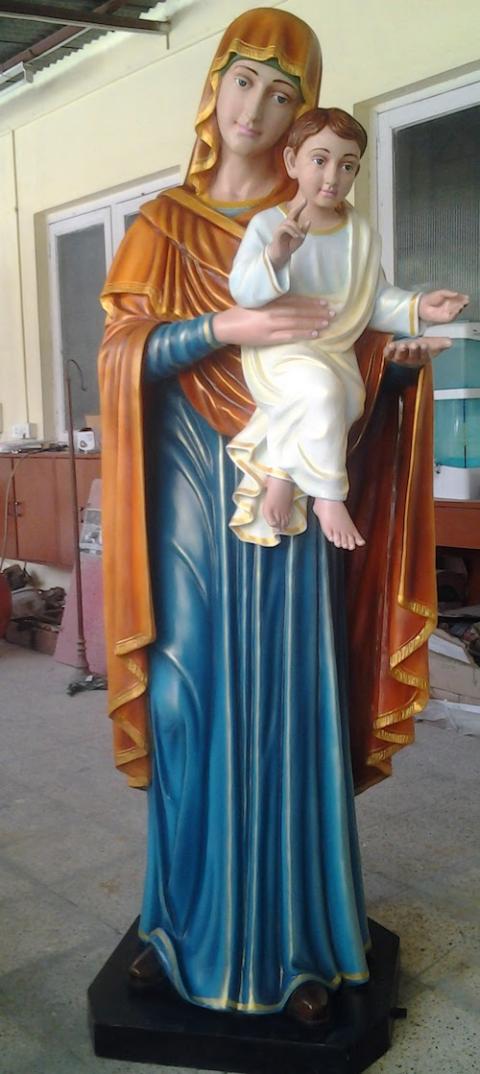
Sr. Vimala Joseph Thottumannil designed this statue of the Blessed Mother, the Patroness of Aviation, installed in Johannesburg, South Africa. (Provided photo)
Share with us how you get an idea of a design for a church.
A church remains a historical symbol. When I get a request for a design, I find out the church's patron saint to use the appropriate symbols. Mostly, the paschal mystery is depicted in the churches I have designed. If it is for a convent chapel, I study the spirituality of that particular congregation and pray over it. Prayer and fasting are very important for divine inspiration.
God continues to bless me with new ideas to design innovative churches across India. It feels good linking my spiritual yearnings with the design themes. In fact, I feel spiritually fulfilled when designing churches.
What types of designs do you use?
I use straight lines, curves and circles. Circles stand for perfection. On request, I do Indian designs. I have done a statue of the Blessed Mother clad in sari and a statue of Jesus as an Indian guru [teacher]. I have designed four chapels with Indian designs for religious congregations. In some places in India, they do not appreciate Indian designs.
Please share some joyful moments and challenges you have encountered in this mission.
I feel very happy and satisfied when a project I proposed is approved, executed and brought into existence. One challenge is the competition in the market. There are many artists in this field, although not many religious priests, brothers or sisters. It's also challenging to convince a client my concept of design. I have another sister working with me.
What are the types of work you are now concentrating on, and how do you execute them?
I focus now on interior design: mosaic art, fiberglass artwork, stained glass and statues.
Once a project is approved, we work on it in our workshop, Domus Dei [House of God] in Bandra, and transport them to destinations in India and abroad. I have supplied design tabernacles to the United States and the Philippines and 80 pieces to Nigeria. Four years ago, I traveled to South Africa with one of our staff to fix a statue we had made for them.
How do you integrate the architecture into the charism of liturgical apostolate?
Our founder, Blessed James Alberione, urged us to be professional in our mission. He encouraged us to dedicate ourselves to embroidery, painting and sculpture and undertake studies in engineering, architecture. So what I am doing is a part of our mission.
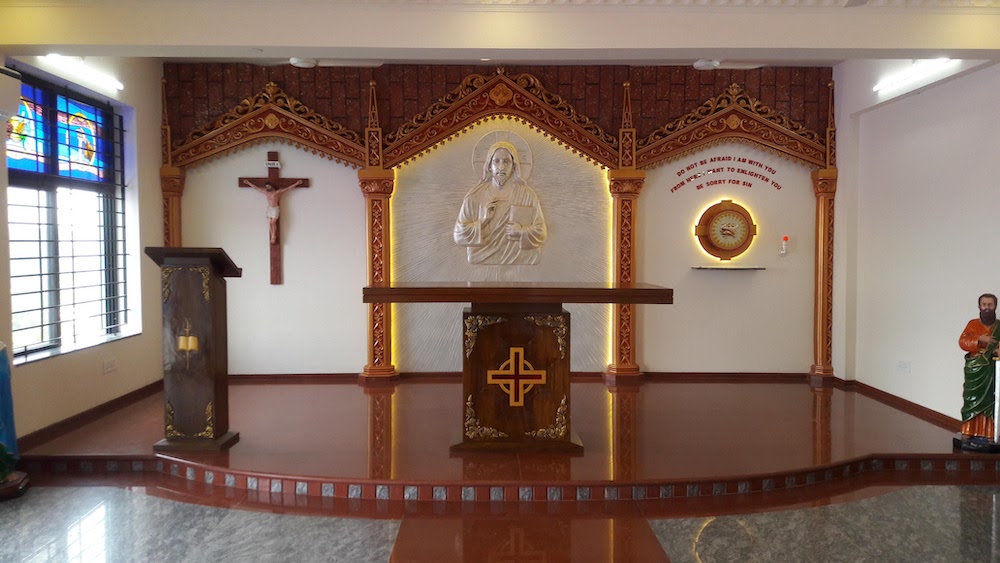
Interior of the Don Bosco chapel at Siliguri in the eastern Indian state of West Bengal, designed by Sr. Vimala Joseph Thottumannil of the Pious Disciples of the Divine Master (Provided photo)
Tell us something about yourself. Why did you become a nun?
I come from a family with an artistic background. My paternal grandfather had carved out a whole house, which still exists. My maternal uncle was a musician. Perhaps I also carried within me some sparks of these artistic gifts. [She laughs.]
I am the second of eight children. My parents were devout Catholics who lived in Thiruvampady in Kerala's Kozhikode [formerly Calicut] district. Our family belongs to the [Syro-Malabar] Diocese of Thamarassery.
One of my school friends told me about her two neighbors who were members of the Pious Disciples of the Divine Master and doing some sort of artwork. I was attracted. When my friend decided to join the congregation, I followed her. My father was not willing to send me, but he agreed finally because of my persistence. I learned about the congregation and its mission only after joining it. [She smiles.]
Do you have a message for young people who want to enter religious life today?
It is worth leaving everything and following Jesus in religious life.
Many young people embrace religious life, even in these days. They are fed up with the high-profile life or high salary. They are looking for a substantial life rooted in deep spirituality, like the three young women who took their first vows in Kerala a month ago. One was a software engineer; another was a medical doctor. The third has a master's degree in computer application.
I feel young people now focus on the essence of life. There are many possibilities open for girls today in the corporate field, yet they opt for religious life. It may be the fruit of a praying family, parents and children. Many girls who join are their parents' only child.
[Lissy Maruthanakuzhy is a member of the worldwide Congregation of the Daughters of St. Paul in India and a correspondent for Matters India, a news portal that focuses on religious and social issues.]

